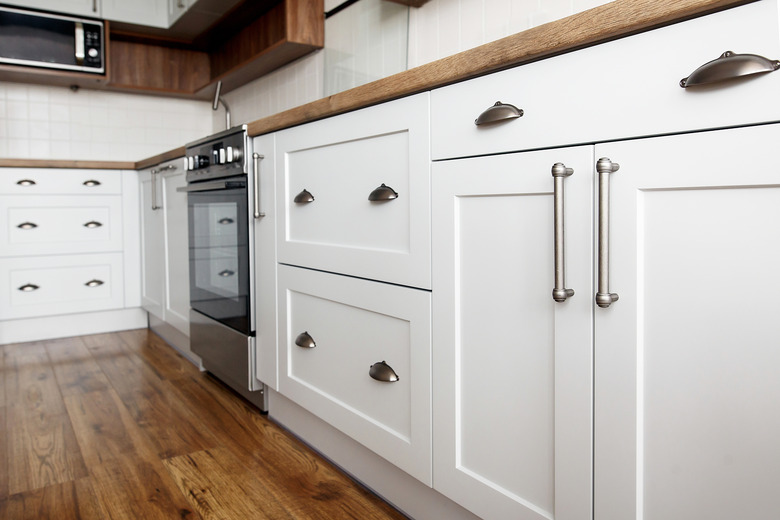How To Clean White Painted Cabinets That Have Yellowed
Has this happened to you? One fine morning, the sunlight hits your kitchen cupboards in such a way that you're aghast at how yellow your once-gleaming cabinets have become. You're not alone, and it's not just white cupboards that grow yellow with age over time; they're just the most noticeable. Luckily, you can make dramatic improvements with a little grunt work and help brighten those yellowing kitchen cabinets.
Tip
"Yellow" cupboards are often caused by defective, aging finishes or airborne grease that settles over everything (even the ceiling!) over time, causing sickly yellow and tacky surfaces. An all-natural homemade cleaning solution can work wonders.
Can They Be Saved?
Can They Be Saved?
Often, discolored kitchen cupboards are caused by grease, grime and time, but some cupboard finishes like vinyl can react to sunlight and become discolored. These kitchen storage spaces must not be exposed to direct sunlight at length and generally aren't warrantied for color-fastness. Such kitchens should have indirect sunlight only, with window film for UV filtering, blinds or sheer curtains. Unfortunately, in instances of sun damage, the discoloration may be permanent.
To find out, try cleaning a spot with the recommended approach below; if it doesn't improve, the yellow may be permanent. Also, some white cupboard products like thermofoil have a history of yellowing and degrading in appearance. This, again, is due to the cupboard makeup and can't be remedied.
Old veneer and varnish can yellow, alkyd-painted cabinets will yellow if they're not in a sunny spot and sometimes it's caused by just plain old defective products. If cleaning isn't effective, you may want to consider some other cosmetic intervention, such as painting with a hard-wearing product like acrylic or enamel paint.
Preparing Your Kitchen
Preparing Your Kitchen
When cleaning your kitchen cabinets, be aware that a whole lot of dirtied cleaning solution will be dripping onto your countertops and floors. It's a good opportunity to do a thorough cleaning of those, too, so get prepared by cleaning everything off the counters for an empty work surface. You'll be surprised how quickly and thoroughly you'll get everything clean without clutter on the counters.
The Best Way to Clean White Kitchen Cupboards
The Best Way to Clean White
Kitchen Cupboards
Mix a solution of ¼ cup baking soda, 4 cups white vinegar and 8 cups warm water in a 2-gallon bucket. (Don't substitute ammonia for vinegar as it can damage some cupboard finishes.) Combine it well, then use clean cloths or sponges to scrub down the doors. You may need to put some effort into this, and it may need more than one pass. Rinse with clean water and dry with a rag.
If stains are particularly stubborn, add baking soda directly to your sponge or cloth and lightly scour. Don't use bleach or abrasive cleaners as they can damage the finish. For very difficult stains, you can try testing a product like Goo Gone or OOPS! in an inconspicuous spot to see if it's OK to use on your cupboards.
Some homeowners swear by using Magic Erasers for tackling the yellow. Be aware that these products are usually safe (and highly effective) but have been known to damage thermofoil cabinet fronts and may harm other materials. Always test it in an inconspicuous place first.
Prevention: Keeping Kitchens Cleaner
Prevention:
Keeping Kitchens Cleaner
You may think you're properly ventilating your kitchen by opening a window when you're cooking, but studies show that most people ventilate inadequately and air quality in kitchens is poor due to airborne grease and other particles. Grease gets in the air and coats everything in the kitchen, even several feet from the stove. Rather than being oily, it causes a yellow and tacky-feeling surface, but don't be fooled – that's grease.
Always use a range hood for ventilating and turn it on before things get smoky. Regular full-cabinet wipe downs and thorough ventilation while cooking will help keep the kitchen gleaming.
